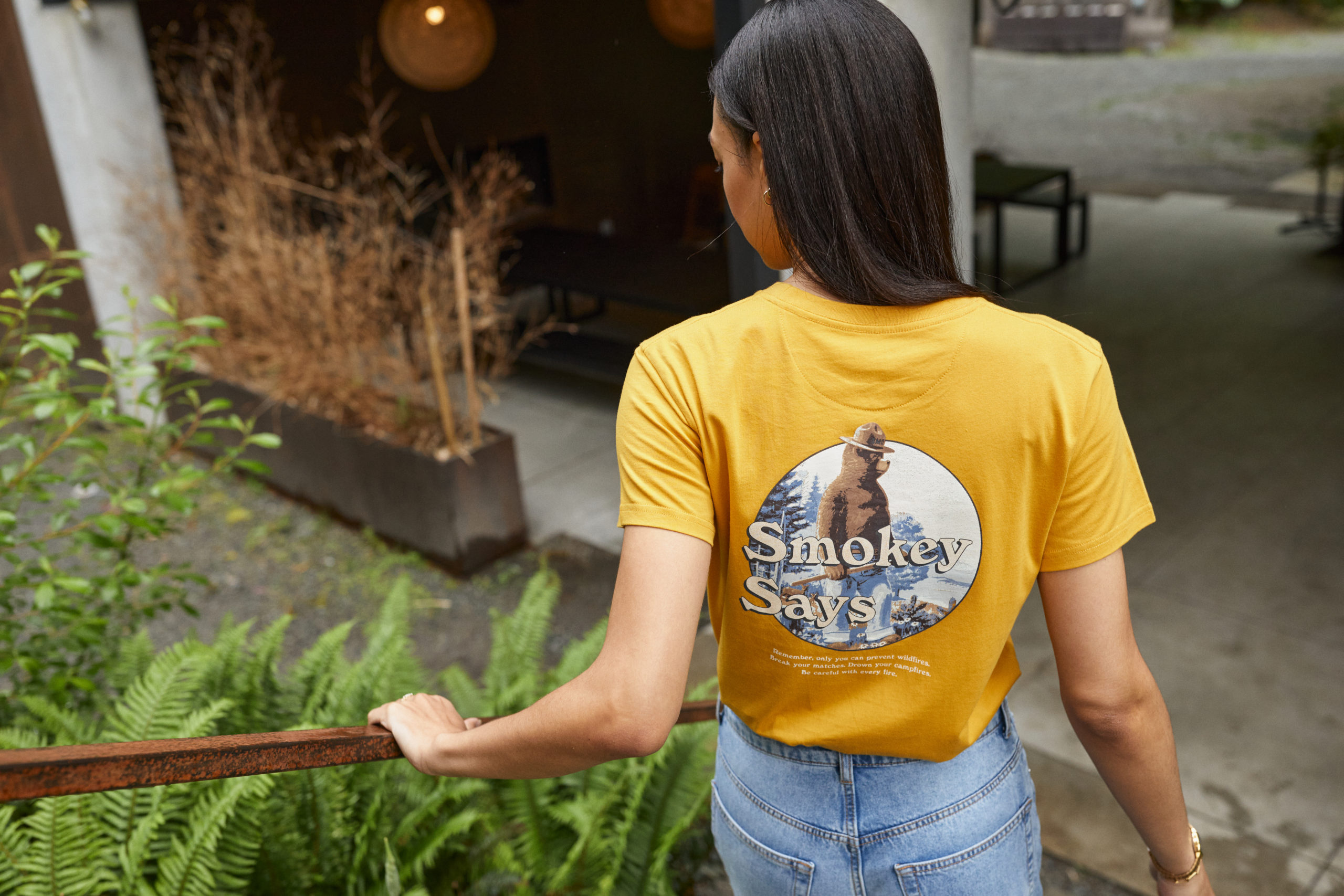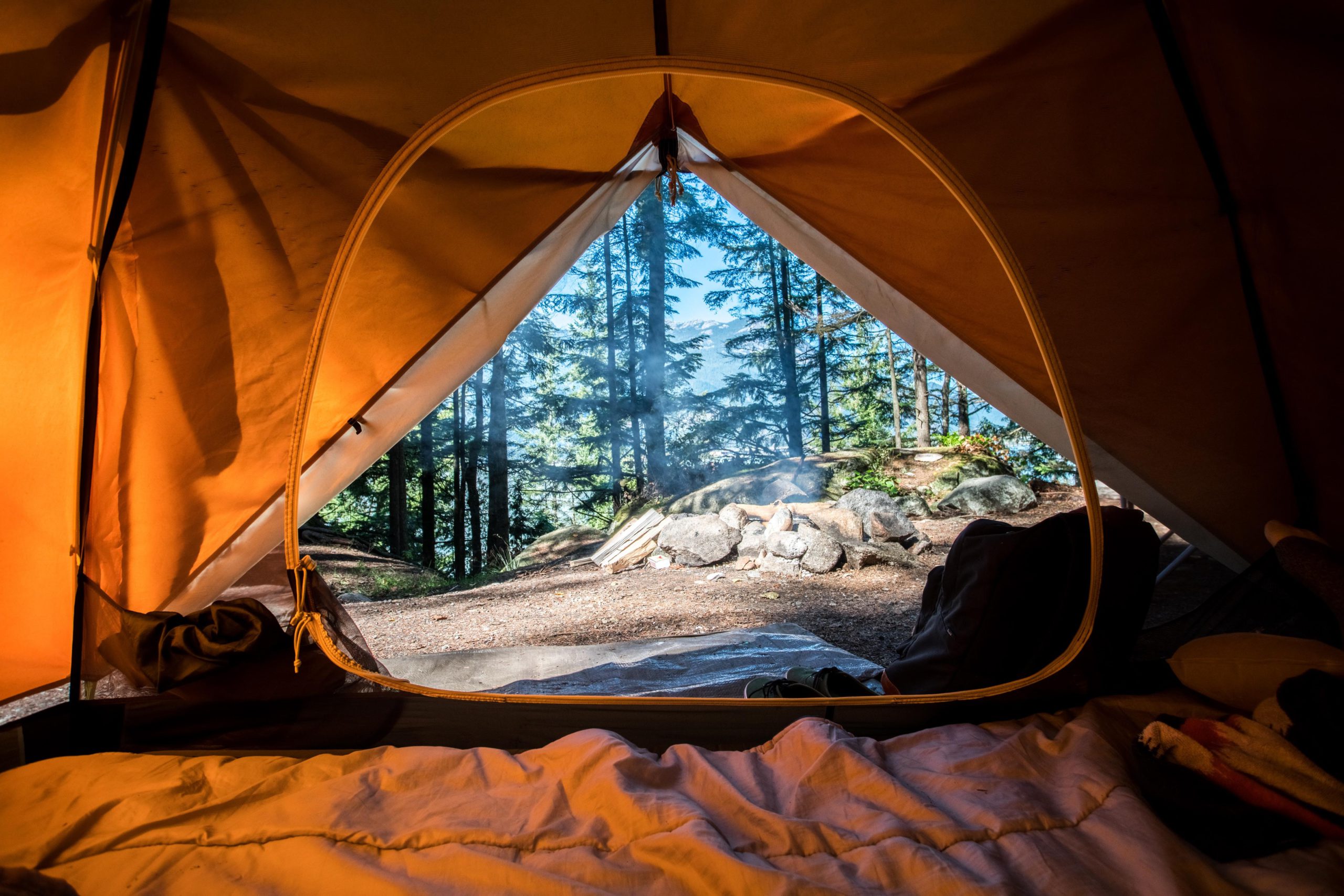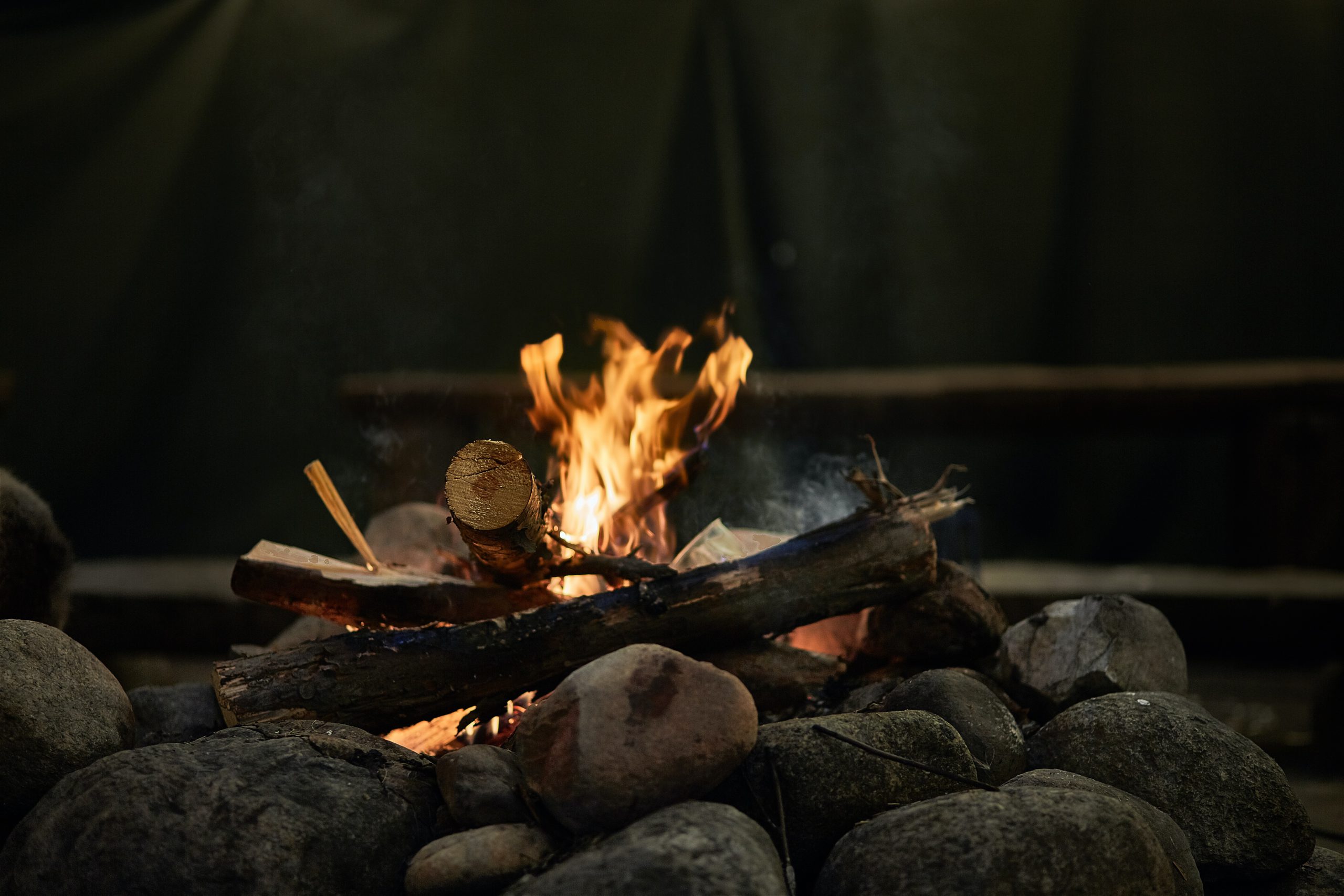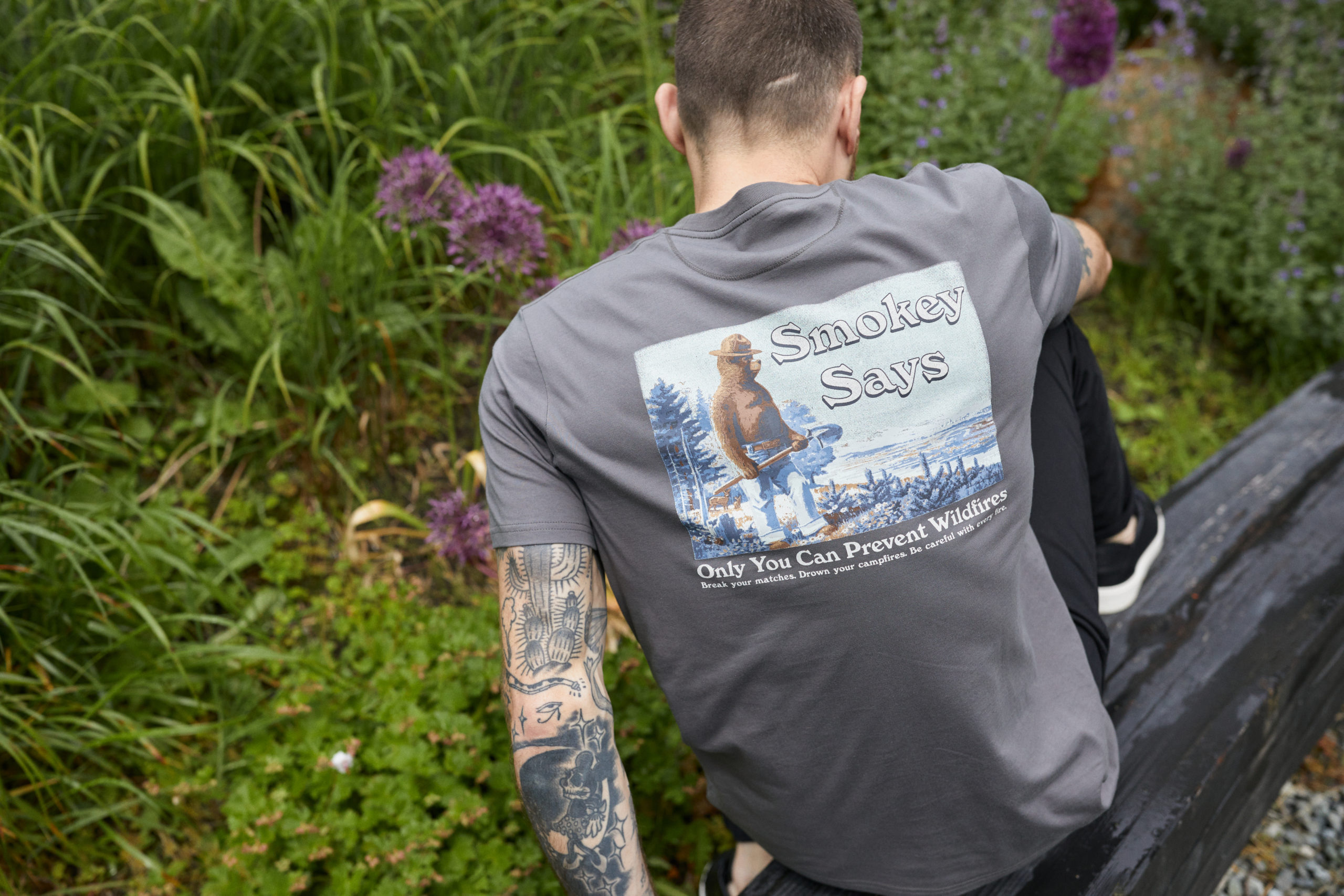Wildfires have become a constant reality across the globe. In North America, wildfire season can last for almost the entire year, devastating homes, wildlife habitats, and forests. The upside is that we have the power to prevent most wildfires. Over 87% of wildfires are started by humans in the US, and 40% in Canada. While naturally occurring wildfires play an important role in clearing out dead litter on the forest floor, returning nutrients to the soil and supporting plant reproduction, human-caused wildfires have the opposite effect. If we all do our part, we can save forests, lives, animals, and ecosystems.

Featured: Women’s Smokey Says T-Shirt
So let’s dive in and learn how you can prevent wildfires and keep our forests safe.
Wildfire Prevention: Out In Nature
Nothing says fall quite like a campfire (complete with s’mores, obviously). Here’s a rundown on how to build your next campfire safely and prevent wildfires. Just keep in mind that these are instructions for contained fires in environments where they’re permitted, and fire bans aren’t in place.
Before we dive in, let’s start with some dont’s:
- We don’t mind repeating ourselves: don’t build a fire during a fire ban. Period.
- Don’t make your own pit if you’re not allowed — use provided fire pits when possible.
- Don’t build a fire in dry, windy conditions.
- Never cut down standing trees to use for firewood, either dead or alive. Live trees don’t burn, and even dead trees provide homes for wildlife.
- Never leave a fire unattended.
- Don’t build a fire near low-hanging branches or excessive brush.
- Don’t build an uncontained fire — always use a fire pit, whether you’ve made it or it’s provided.
1. Respect fire bans
Before you build a fire, always check to see if a fire ban is in effect and respect it. These bans are in place to protect the local environment during the hottest, driest and most vulnerable months.
2. Pick a good campfire spot
If you’ve found an area where you can safely build your own fire, find a spot at least 15 feet from your tent, plus shrubs, trees or anything else flammable, like brush and decaying leaves. Look up and make sure to avoid low-hanging branches.

3. Prep your campfire pit
Clear 10 feet around your spot from leaves, twigs and other flammable debris, including that bundle of firewood you just bought. Dig a fire pit in the dirt about one foot deep, ideally in sand, gravel or mineral soil to minimize the chance of sterilizing healthy soil, circle it with rocks, and you’re good to go. Fire pits, whether provided or handmade, lessen your impact and keep your fire contained.
4. Prep your campfire materials
In Canada, it’s illegal to collect and burn wood from the forest in most National and Provincial Parks. Same goes in the US. If you’re camping in a protected park, only use the firewood you’ve purchased locally. Bring tinder from home to help start your fire. Crumpled newspaper, dryer lint or firestarters will do the trick. Create your own kindling — smaller pieces of wood — by chopping your firewood with a hatchet. You’ll need small and mid-size pieces to build the base of your fire and then keep the fire going. Lastly, you’ll need logs, or fuel wood, to keep your fire burning once it’s fully started.
If you’re outside of a protected park, you can gather tinder, kindling and fuel from the local area (unless local guidelines say otherwise). Small twigs and dry leaves make for good tinder, use sticks less than one inch around as kindling, and larger pieces of wood can serve as your fuel. Always be mindful of the local environment, and never cut down standing trees or branches, dead or alive.
Finally, have a source of water, a bucket and a shovel around just in case, so you can put out your campfire if it gets out of control.
5. Build a good campfire
Start by piling the tinder in the centre of the pit, then add your kindling. There are four styles of fires you can build with your kindling, depending what you want to use your campfire for.

Want to cook over your campfire? Use either the:
- Tent: lay the kindling over the tinder like you’re building a tent.
- Lean-to: drive a long piece of kindling into the ground at an angle over the tinder. Lean smaller pieces of kindling against the longer piece.
Looking for more of a social fire? Try these methods:
- Cross: crisscross the kindling over the tinder.
- Log cabin: surround your pile of tinder with kindling, stacking pieces at right angles. Top the “cabin” with the smallest kindling.
If you’re using matches to light your fire, make sure they’re cold before discarding them into the fire.
Continually add more tinder, blow on the base to keep your fire, and add kindling and fuel to keep the fire going. Just make sure to keep the fire small and under control.
Some things to never throw in the campfire? Aerosols, glass, or aluminium cans. They can combust, shatter, or create harmful fumes and dust. Not good for people or the planet.
6. Extinguishing your fire
The night is winding down and you’re ready to ditch your firepit. Here’s how to do that safely.
Allow the wood to burn completely to ash, if possible. Pour lots of water on the fire, drowning all of the embers (not just the red ones). Pour until hissing sound stops. If you don’t have water on hand, stir dirt or sand into the embers with a shovel to bury the fire.
With your shovel (or a stick), scrape any remaining logs to remove any embers. Make sure that no embers are exposed or smoldering. Continue adding water, dirt or sand and stirring until all material is cool.
Now, high-fives: you’ve safely enjoyed a campfire.
One more tip: Before you head out into the backcountry or your favourite campsite, add the local park ranger office’s number in your phone. That way if you spot a fire, you can let the right people know to prevent the spread.
Wildfire Prevention: At Home
You don’t have to leave your house to prevent wildfires. Some of the biggest changes (and the simplest) start at home. Here are some small tweaks you can make around your house to reduce the potential spread of wildfires, especially if you live in a fire-prone climate.
- Clean under your deck, in your gutters and your roof from leaves, debris and other combustible material.
- Keep a 1.5 meter non-combustible zone around your home.
- Keep grass and weeds cut below 10 cm.
- Move firewood and propane tanks 10-30 meters away from your home.
- Prune trees to create a two meter clearance from the ground to the lowest branches.
- Landscape using fire-resistant plants and shrubs. Deciduous (leafy) trees like poplar, maple, aspen, alder and cherry trees are resistant to wildfire. Avoid spruce, fir, pine, cedar, juniper and tall grass when landscaping, as these are all highly flammable.
Stay informed about wildfires in your area and around the world with tech. Both NASA and the Fire, Weather and Avalanche Center have informative websites, and the Wildfire Info app allows you to get updated details about current wildfires across the globe and prescribed burn activity for locations in the U.S., Canada, Europe, Australia, and more. Download it for your iPhone or Android.
We get it — wildfires can be pretty scary and overwhelming to talk about. Just remember that most wildfires are preventable and we all have a responsibility to do our part to prevent wildfires where we live, work and play. All it takes is living responsibly to protect the planet, outdoor spaces, and communities we call home. We’re in this together.
Want to spread the message of wildfire prevention and plant trees while you’re at it? Shop The Smokey Bear Collection.

Featured: Men’s Smokey Says T-Shirt
Keep Reading
Tree Planting Site: Plumas National Forest, California, USA
By planting ten trees for every item you purchase, it’s our mission to plant 1 billion trees by 2030. Head to our website to learn more and begin your planting journey with 10% off.

